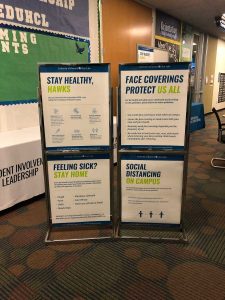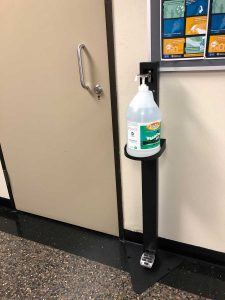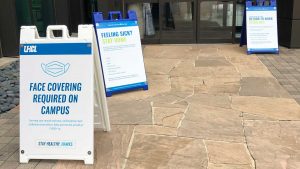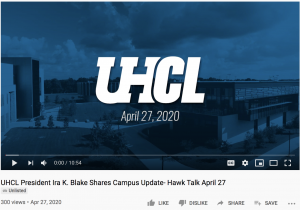EDITORIAL: UHCL’s fall semester opens successfully
Since March 11, classrooms at UHCL have remained virtually empty. Students traded in their school clothes for pajamas. Instructors traded in classrooms for Zoom meetings.
The spring semester ended with a whisper as Spring 2020 graduates stayed home and watched their names and photos crawl across a PowerPoint slide.
Summer classes were exclusively online with the campus open to limited emergency personnel for the most part. Even though the library and Patio Café closed their doors to students and masked administrators were the only ones to roam the campus halls, everyone knew UHCL would reopen.
UHCL reopens with few students roaming campus halls

UHCL released its Fall Opening Plan Aug. 14. Guided by both Governor Greg Abbott’s Open Texas plan and Harris County officials, UHCL made the move to have all classes taught bimodally or online with art studios and labs offered as scheduled.
Under this plan, UHCL employees could choose to work from home if their work allows, but offices could not staff more than 50% of their employees at the same time. Masks would be enforced, hand sanitation stations made available in every classroom and in common areas, the Patio Café would reopen, but Neumann Library would continue online.
UHCL has a plan, a really good plan.
Universities fail across America
As TikTok and news organizations across America have shown, universities, as a whole, are not handling reopening well.
New York University is serving quarantine students lemons and watermelon chicken salad. The University of Michigan is quarantining students who test positive for COVID-19 in roach-infested apartments with only a single roll of toilet paper. As of Sept. 13, 2,342 students at the University of Alabama tested positive for COVID-19.
UHCL is in a unique situation. A formerly upper-level commuter university recently turned into a four-year institution with a single 1-year-old residence hall, UHCL exists in a weird transition bubble.
UHCL administration, instead of having to focus on how thousands of students would be housed, was able to spend their time and money wisely on making sure students were well-equipped for the fall semester.
CARES Act allowed UHCL to provide financial care to students
While UHCL did receive CARES funding for students impacted by COVID-19, on March 25, administrators implemented an Online Learning Assistance and Reimbursement Program (oLARP), which allows students a one-time reimbursement ― up to 80% ― of the cost of a new computer.
The University Computing and Telecommunications (UCT) team created a way for students to access computers on campus through a virtual private network, but that does not help the students who do not have access to a reliable computer or high-speed internet. The oLARP program is incredibly necessary for students who use campus computers to complete their coursework but were not expecting to have to suddenly make a large purchase.
UCT and oLARP brought campus computer labs to students’ homes. UHCL boasts about being “the solution” but sometimes only provides “a solution.” However, with the UCT and oLARP systems, UHCL proved it can live up to its promise.
Funding and monetary expenses
UHCL does not have a traditional residential campus with numerous dorms or Greek life, so administrators could afford to spend CARES Act funds on the students and on the safety of the UHCL community.

Sanitary sprays, hand sanitizers, single-sided plexiglass barriers, face masks, face shields and three-sided plexiglass shields are just some of the safety precautions UHCL has implemented on campus using funding from the CARES Act.
As of Sept. 15, not all of these tools are currently in use. Administrators wanted to make sure they did not fail the safety of the UHCL community because they did not want to spend the money. UHCL ordered a high quantity of these supplies – there are still supplies available that are not currently in use.
UHCL now has “classroom kits” full of hand sprays and paper masks that are available for any professor to use for their face-to-face classes. New student worker jobs were created to refill these kits as needed which is super important since some student worker positions were cut during the pandemic.
UHCL does not (and plans not to) use temperature checks on those coming into campus buildings. Additionally, the university partnered up with county officials to provide free COVID-19 testing to the UHCL community twice now, with another event taking place in October.

UHCL also received an extra $400,000 in funding for being a minority-serving institution. Instead of choosing to supplement their budget for safety or to pay down the debt for the Campus Recreation and Wellness Building or Student Services and Classroom Building, UHCL administrators served the interest of the minority students and gave every single penny to provide aid to students who were in financial need through the COVID-19 Emergency Fund.
Even though UHCL received $5.8 million in governmental funding, $2.7 million of that was required to go directly to students. COVID-19 is estimated to cost the university $2 million more than the CARES Act provided; UHCL could have chosen not to give students anything from the extra $400,000, but administrators put students first instead.
Where UHCL excels the most
Transitioning from in-person courses took a toll on UHCL students and faculty, who went above and beyond what was expected and required of them in order to continue to provide the best possible education for their students.
While some faculty members have experience in teaching online courses, there are professors who have never taught an online course or actively used Blackboard. The Center for Faculty Development (CFD) and UCT had solutions for those professors.
Most of the university’s professors are 9-month faculty under contract and there are no requirements or expectations for them to teach a summer course or further their studies in pedagogy.
However, faculty at UHCL worked alongside the CFD and instructional designers from UCT to provide workshops, seminars, one-on-one support and faculty-led events for those who may have not known how to teach students successfully online.
UHCL administration ensured the success of faculty by having someone from the Faculty Senate in core leadership meetings to figure out how to plan for the summer and fall semesters. This was critical to the reopening’s success. While UHCL administrators do interact with students, it is not the same level of interaction between students and faculty: faculty can provide a unique perspective on students’ needs and desires in core leadership and upper-level administrative meetings.
Communication, consistency remains key
While communication from UHCL during the months of August and September was frequent, that does not mean it was OK for UHCL administration to not keep students as informed as possible during the preceding months.
Furthermore, communication that was not sent via email was even spottier. The president’s “Hawk Talks” series ended in May with no reason given to students. Understandably, videos take time and manpower to produce – resources not easily spared these days.

Additionally, “Hawk Talk” videos still remain unlisted and cannot be found on the university’s Facebook page. Shorter, more frequent emails, communications and short videos available to find with a simple Google search would be much more beneficial to students.
The town halls hosted by university administration aimed to discuss the pandemic were undercut by the university’s inability to give clear assurances during the social unrest highlight by the murder of George Floyd.
The administration originally did not have much of a presence at the Student Government Association’s (SGA) town halls, save for Aaron Hart, vice president of student affairs, David Rachita, dean of students, and Iliana Melendez, associate dean of students, who all made regular appearances.
However, once SGA began its meetings for the 2020-2021 school year, more administrators began to have a presence, including President Ira K. Blake, Provost Steven Berberich, Vice President of Administration and Finance Mark Denney and Vice President for University Advancement Joseph Staley.
This is real progress – it is incredibly helpful for students to have a place where they can directly talk with administrators. Making sure the administration is available to students is intrinsic to a successful university. This should become the new normal, not just in times of crisis.
What’s to come in the future
The pandemic is devastatingly horrific, but that does not mean it cannot provide a blueprint for possible future emergency situations. The Federal Emergency Management Agency’s National Incident Management System provides guidance for UHCL and its emergency management policy. The odds of having another COVID-19-sized pandemic is unlikely. However, that does not mean emergencies at UHCL are unlikely.
UHCL is located in a prime location for hurricanes and tropical storms. In the past year, Tropical Storm Imelda, Hurricane Laura and Tropical Storm Beta have all threatened the greater Houston area. UHCL’s responses have varied widely in these emergency situations.
The communication with students during Hurricane Imelda was, in a word, abysmal. However, UHCL seemingly has learned from its mistakes and the communication during Hurricane Laura and Tropical Storm Beta was surprisingly good.
It appears the UHCL administration has taken lessons from mistakes made early in the pandemic and past weather-related emergencies – as it should.
Since August, UHCL has sent out text messages, social media posts and numerous emails to students consistently updating them on the situations in the Gulf of Mexico and letting them know if and when UHCL’s campus would close.
This is 2020, everyone needs to look for the wisps of silver linings. If UHCL can use the tragedy of the pandemic to provide further insight into future plans, they should be applauded.
UHCL’s fall 2020 semester is by far more successful than other universities across the country because the administration listened to its faculty and health officials and grew from past mistakes.

